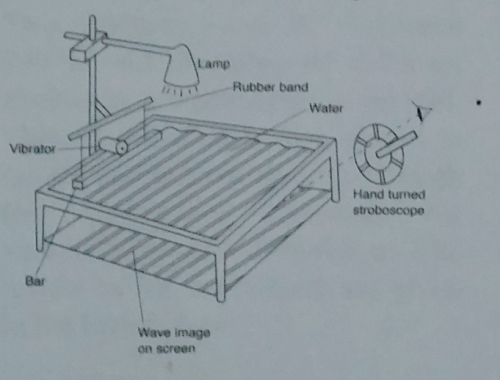Wave is a form of energy. Wave energy is useful as well as dangerous to human beings. Communication technology uses concept of waves as its fundamentals. Earth quakes are as a result of seismic waves resulting from shifting of locks within the earth.
Phenomenon’s like formation of rainbows formation, mirages and thin films in oil shows presence of waves. Variations in quality of sound from musical instruments is based on the properties of waves.
Wave properties can be investigated by use of a ripple tank. Waves exhibits various properties that can be conveniently illustrated using a ripple tank.
The ripple tank
Ripple tank helps us study properties of water waves. Studying water waves can help us explain the characteristics of other types of waves such as light and sound waves.
Ripple tank consists of:
- a transparent tray containing water
- a point source of light above the tray
- white paper screen and
- an electric motor.
The white screen is underneath the tray while the electric motor is on the surface of the water in the tray. The figure below shows the basic structure of the ripple tank.

The water waves are the ripples traveling across the surface of the shallow water in the tray . This ripples are produced by the vibrations of the electric motor.
When you deep a finger in water, a pulse of wave is usually produced. This circular wave radiates outwards from the source of disturbance. This pulse in water is called a ripple. water ripples are progressive as they continuously propagate away from the source.
How ripple tank is used
A generator enables generation of continuous ripples. The electric motor is mounted on a wooden bar on a ripple tank. When the motor is started, the bar is made to vibrate by an electric metal disc on the axle of the motor.
To generate continuous straight waves, the length of the bar is adjusted so that it just touches the water surface. To generate continuous circular waves , a small ball called a dipper fitted to the bar is adjusted so that it just touches the water surface.see the figure below:

The figure below shows circular and line waves:
When the light from the lamp passes through the waves , the images of the waves are projected on the paper underneath.
Since the bottom of the tray is transparent, the light casts an image of the passing waves on the screen. When light from the lamp is passing through the water, the curve of the water surface acts like a series of lenses. These lenses are both converging and diverging that focus light to create a series of bright and dull lines. The wave crests produce bright lines while troughs produce dark lines. see the figure below.

To cut down unwanted reflections, the sides of the tray is aligned with spongy material.
For easier observations of the progressive waves, a stroboscope is used.
Stroboscope
A stroboscope is a disc with equally spaced slits which can be rotated by hand or a motor. If the speed of rotation is such that the wavefront advances one wavelength each time a slit passes through the eye, the wave fonts appears to be stationary. The waves are then said to be frozen.
Another type of stroboscope is made up of a lamp which flashes light on and off at a controllable measurable rate. At a frozen motion, the successive appearance of the slits at a particular point matches exactly with the period of the wave. this gives persistence of vision as the eye receives glimpses of the waves at the same level of displacement each time. The figure below illustrates observation of water waves through a stroboscope.

The wave pattern is represented by wavefronts lines that connects all the points that are in phase as the wave progresses. It follows that the distance between successive wave-fronts is equal to one wavelength.
Vocabulary of waves
oscillation
Also known as vibration. oscillation is when a wave makes one complete cycle of to and fro motion about the mean position.
the figure below illustrates a wave making one oscillation:

Amplitude
It is the maximum displacement of a particle from its rest position.

wavelength
This is the distance between two successive particles which are in phase and are moving to the same direction.

Frequency f
This is the number pf oscillations made by the wave in one second.

